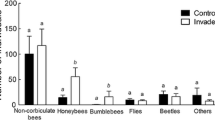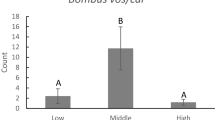Abstract
Many invasive alien plants occur in large populations with abundant flowers which are highly attractive to pollinators, and thus might affect pollination of co-occurring native species. This study focuses on the invasive Heracleum mantegazzianum and distance-dependent effects on pollination of Mimulus guttatus in abandoned grassland over 2 years. First, we examined pollinator abundance in yellow traps at 0, 10, 30 and 60–200 m from H. mantegazzianum. We then placed M. guttatus plants at the same distances to monitor effects of the invasive species on pollinator visitation and seed set of neighbouring plants. Finally, we conducted a garden experiment to test if deposition of H. mantegazzianum pollen reduces seed set in M. guttatus. No distance effect was found for the number of bumblebees in traps, although the invasive species attracted a diverse assemblage of insects, and visitation of M. guttatus was enhanced close to H. mantegazzianum. This positive effect was not reflected by seed set of M. guttatus, and heterospecific pollen decreased seed set in these plants. Overall there is little evidence for negative effects of the invasive species on pollination of neighbouring plants, and flower visitation even increases close to the invaded patches. The functional role of the invader and suitable control strategies need further clarification, since removal of H. mantegazzianum may actually damage local pollinator populations.




Similar content being viewed by others
References
Aigner PA (2004) Ecological and genetic effects on demographic processes: pollination, clonality and seed production in Dithyrea maritime. Biol Conserv 116:27–34
Amiet F (1996) Insecta Helvetica Fauna 12, Hymenoptera Apidae, 1. Teil, Allgemeiner Teil, Gattungsschüssel, die Gattungen Apis, Bombus und Psithyrus. Schweizerischen Entomologischen Gesellschaft, Neuchatel, Switzerland
Appanah S (1993) Mass flowering of dipterocarp forests in the aseasonal tropics. J Biosci 18:457–474
Bell JM, Karron JD, Mitchell RJ (2005) Interspecific competition for pollination lowers seed production and outcrossing in Mimulus ringens. Ecology 86:762–771
Bergman P (1996) Early flowers of Bartsia alpina (Scrophulariaceae) and the visitation of bumblebees. Acta Bot Neerl 45:355–366
Bertsch A, Schweer H, Titze A, Tanaka H (2005) Male labial gland secretions and mitochondrial DNA markers support species status of Bombus cryptarum and B. magnus (Hymenoptera, Apidae). Insect Soc 52:45–54
Bjerknes AL, Totland Ø, Hegland SJ, Nielsen A (2007) Do alien plant invasions really affect pollination success in native plant species? Biol Conserv 138:1–12
Brown BJ, Mitchell RJ (2001) Competition for pollination: effects of pollen of an invasive plant on seed set of a native congener. Oecologia 129:43–49
Brown BJ, Mitchell RJ, Graham SA (2002) Competition for pollination between an invasive species (Purple loosestrife) and a native congener. Ecology 83:2328–2336
Caruso CM, Alfaro M (2000) Interspecific pollen transfer as a mechanism of competition: effect of Castilleja linariefolia pollen on seed set of Ipomopsis aggregate. Can J Bot 78:600–606
Chittka L, Schürkens S (2001) Successful invasion of a floral market—An exotic Asian plant has moved in on Europe’s river-banks by bribing pollinators. Nature 411:653
De Waal LC, Child LE, Wade PM, Brock JH (1994) Ecology and management of invasive riverside plants. Wiley, Chichester
Dole JA (1990) Role of corolla abscission in delayed self-pollination of Mimulus guttatus (Scrophulariaceae). Am J Bot 77:1505–1507
Dole JA (1992) Reproductive assurance mechanisms in three taxa of the Mimulus guttatus complex (Scrophulariaceae). Am J Bot 79:650–659
Drake JA, Mooney HA, di Castri F, Groves RH, Kruger FJ, Rejmánek M, Williamson M (1989) Biological invasions. A global perspective. Wiley, Chichester
Dramstad WE (1996) Do bumblebees (Hymenoptera: Apidae) really forage close to their nests? J Insect Behav 9:163–182
Ellenberg H (1988) Vegetation ecology of Central Europe. Cambridge University Press, Cambridge
Galen C, Gregory T (1989) Interspecific pollen transfer as a mechanism of competition: consequences of foreign pollen contamination for seed set in the alpine wildflower, Polemonium viscosum. Oecologia 81:120–123
Ghazoul J (2004) Alien abduction: disruption of native plant-pollinator interactions by invasive species. Biotropica 36:156–164
Grabas GP, Laverty TM (1999) The effect of purple loosestrife (Lythrum salicaria L; Lythraceae) on pollination and reproductive success of sympatric co-flowering wetland plants. Ecoscience 6:230–242
Grace J, Nelson M (1981) Insects and their pollen loads at a hybrid Heracleum site. New Phytol 87:413–423
Grime JP (2001) Plant strategies, vegetation processes, and ecosystem. Wiley, Chichester
Hammer K, Holm S (1970) Danske humlebier og snyltehumler. Natur og Museum, Naturhistorisk Museum, Århus, Denmark
Hansen K (ed) (1999) Dansk feltflora. Gyldendal, Copenhagen, Denmark
Harder LD, Williams NM, Jordan CY, Nelson WA (2001) The effects of floral design and display on pollinator economics and pollen dispersal. In: Chittka L, Thomson JD (eds) Cognitive ecology of pollination. Cambridge University Press, Cambridge, pp 297–317
Heinrich B (1975) Energetics of pollination. Ann Rev Ecol Syst 6:139–170
Krupnick GA, Weis AE, Campbell DR (1999) The consequences of floral herbivory for pollinator service to Isomeris arborea. Ecology 80:125–134
Larson DL, Royer RA, Royer MR (2006) Insect visitation and pollen deposition in an invaded prairie plant community. Biol Conserv 130:148–159
Lobo JA, Quesada M, Stoner KE, Fuchs EJ, Herrerias-Diego Y, Rojas J, Saborio G (2003) Factors affecting phenological patterns of bombacaceous trees in seasonal forests in Costa Rica and Mexico. Am J Bot 90:1054–1063
Lodge DM (1993) Biological invasions—lessons for ecology. Trends Ecol Evol 8:133–37
Lopezaraiza-Mikel ME, Hayes RB, Whalley MR, Memmott J (2007) The impact of an alien plant on a native plant-pollinator network: an experimental approach. Ecol Lett 10:539–550
Macnair MR, Macnair VE, Martin BE (1989) Adaptive speciation in Mimulus: an ecological comparison of M. cupriphilus with its presumed progenitor, M. guttatus. New Phytol 112:269–279
Moragues E, Traveset A (2005) Effect of Carpobrotus spp on the pollination success of native plant species of the Balearic Islands. Biol Conserv 122:611–619
Nielsen C, Ravn HP, Nentwig W, Wade M (2005) The giant hogweed best practice manual. Guidelines for the management and control of an invasive weed in Europe. Forest & Landscape, Hørsholm, Denmark
Ohashi K, Yahara T (2001) Behavioural responses of pollinators to variation in floral display size and their influences on the evolution of floral traits. In: Chittka L, Thomson JD (eds) Cognitive ecology of pollination. Cambridge University Press, Cambridge, pp 274–296
Olesen JM, Jordano P (2002) Geographic patterns in plant-pollinator mutualistic networks. Ecology 83:2416–2424
Olesen JM, Eskildsen LI, Venkatasamy S (2002) Invasion of pollination networks on oceanic islands: importance of invader complexes and endemic super generalists. Div Distrib 8:181–192
Osborne JL, Williams IH (2001) Site constancy of bumblebees in an experimentally patchy habitat. Agr Ecosyst Environ 83:129–141
Osborne JL, Clark SJ, Morris RJ, Williams IH, Riley JR, Smith AD, Reynolds DR, Edwards AS (1999) A landscape-scale study of bumble bee foraging range and constancy, using harmonic radar. J Appl Ecol 36:519–533
Proctor M, Yeo P, Lack A (1996) The natural history of pollination. The New Naturalist, Harper & Collins Publishers, London, UK
Prŷs-Jones OE, Corbet SA (1991) Bumblebees Naturalists’ Handbooks 6. Richmond Publishing Co Ltd., Slough
Rathcke B (1983) Competition and facilitation among plants for pollinators. In: Real L (ed) Pollination biology. Academic Press, New York, pp 305–329
Rathcke B (1988) Interaction for pollination among co-flowering shrubs. Ecology 69:446–457
Ritland K (1990) Inferences about inbreeding depression based on changes of the inbreeding coefficient. Evolution 44:1230–1241
Ritland C, Ritland K (1989) Variation of sex allocation among eight taxa of the Mimulus guttatus species complex (Scrophulariaceae). Am J Bot 76:1731–1739
Sakai AK, Allendorf FW, Holt JS, Lodge DM, Molofsky J, With KA, Baughman S, Cabin RJ, Cohen JE, Ellstrand NC, McCauley DE, O’Neil P, Parker IM, Thompson JN, Weller SG (2001) The population biology of invasive species. Ann Rev Ecol Syst 32:305–332
Southwood TRE, Henderson PA (2000) Ecological methods. Blackwell Science, Oxford
Teräs I (1985) Food plants and flower visits of bumblebees (Bombus: Hymenoptera, Apidae) in southern Finland. Acta Zool Fenn 179:1–120
Thomson JD (1981) Field measures of flower constancy in bumblebees. Am Midl Nat 105:377–380
Totland Ø, Nielsen A, Bjerknes AL, Ohlson M (2006) Effects of an exotic plant and habitat disturbance on pollinator visitation and reproduction in a boreal forest herb. Am J Bot 93:868–873
Traveset A, Richardson DM (2006) Biological invasions as disruptors of plant reproductive mutualisms. Trends Ecol Evol 21:208–216
Truscott A-M, Soulsby C, Palmer SCF, Newell L, Hulme PE (2006) The dispersal characteristics of the invasive plant Mimulus guttatus and the ecological significance of increased occurence of high-flow events. J Ecol 94:1080–1091
Vickery RK (1978) Remarkable waxing, waning, and wandering of populations of Mimulus guttatus: an unexpected example of global warming. Great Basin Nat 59:112–126
Waser NM (1978) Competition for hummingbird pollination and sequential flowering in two Colorado wildflowers. Ecology 59:934–944
Waser NM, Real LA (1979) Effective mutualism between sequentially flowering plant species. Nature 281:670–672
Weidema IR (2000) Introduced species in the Nordic countries. Nordic Council of Ministers, Copenhagen, Denmark
Westrich P (1989) Die Wildbienen Baden-Württembergs. Ulmer, Stuttgart, Germany
Willems JH, Lahtinen ML (1997) Impact of pollination and resource limitation on seed production in a border population of Spiranthes spiralis (Orchidaceae). Acta Bot Neerl 46:365–375
Zavaleta ES, Hobbs RJ, Mooney HA (2001) Viewing invasive species removal in a whole-ecosystem context. Trends Ecol Evol 16:454–459
Acknowledgements
We thank Mads Nielsen for field work assistance and Mai-Britt Sauer for help in the greenhouse. Thanks to Henning Bang Madsen, University of Copenhagen, for verification of bumblebee species and identification of solitary bees. The study was supported through a PhD fellowship of the University of Copenhagen to CN, and a study grant by the Paul + Maria Kremer-Stiftung to CH.
Author information
Authors and Affiliations
Corresponding author
Electronic supplementary material
Below is the link to the electronic supplementary material.
Rights and permissions
About this article
Cite this article
Nielsen, C., Heimes, C. & Kollmann, J. Little evidence for negative effects of an invasive alien plant on pollinator services. Biol Invasions 10, 1353–1363 (2008). https://doi.org/10.1007/s10530-007-9210-1
Received:
Accepted:
Published:
Issue Date:
DOI: https://doi.org/10.1007/s10530-007-9210-1




